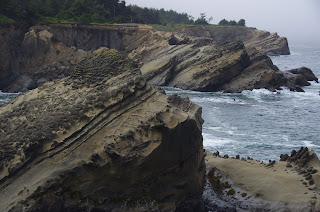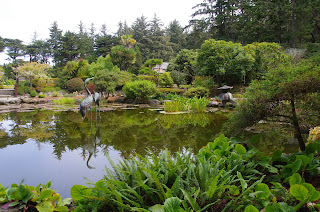Sadly, the name has by now been bowdlerized to "The Times Colonist". And over the past several days I got the distinct impression that BC is now more PC, as it were. Victoria doesn't seem anywhere near as quaint as it did, although Afternoon Tea at the Empress Hotel still seemed very traditional. We had sandwiches, scones with jam, and of course endless refills of excellent tea by an overly attentive waiter.
We've been to Canada at least four times that I can remember in recent years: cycling in Nova Scotia, skiing in Quebec, attending a conference in Banff, and now in the Enterprise. I've invariably found the Canadians to be friendly, helpful, and welcoming. But more than that, I feel a noticeable difference between the Canadian Way of Life and the American Way of Life. In Canada it's more of "we're all in this together" as opposed to the American "it's every man for himself". Possibly just my imagination, but I don't think so. As just one example, the Canadians actually have a decent universal health care system.
We arrived in Victoria from Port Angeles aboard the MV Coho and were greeted as we left the pier by a friendly but inquisitive Canadian immigration official. She was most interested in how many guns we had and where we kept them. After being assured that we had no guns, mace, or tasers, she went on to fruits and vegetables, and sadly proceeded to relieve us of the last of our excellent Oregon apples. We drove around the harbor past the Parliament building, pictured above at sunset, to the Empress where we took another camping break for the two days in Victoria.
Our first full day took us to the spectacular Butchart Gardens:
If you are ever lucky enough to visit Victoria, the gardens are an absolute must-see. Mr. Butchart amassed a fortune in the cement business which involved quarrying limestone, among other things. The photo above is from the portion of the gardens called "the sunken garden" which was the abandoned limestone quarry, until Mrs. Butchart had the idea that it needed to be spruced up a bit. An interesting sidelight: the gardens are still owned by the descendants of the Butcharts. Every privately owned tourist attraction I've ever seen, except for this one, has been somewhat garish and tasteless. Perhaps we have here another example of contrast between the two countries? Or maybe I just haven't yet come across any of the elegant privately owned tourist attractions in the U.S.
The next morning we visited the BC Museum before driving up the island to Nanaimo. They had a somewhat ordinary display of dinosaurs on the second floor, but on the third floor, devoted to the human history of British Columbia, we found an impressive display featuring, among other things, replicas of Captain Vancouver's ship, a coal mine, an early fish canning plant, and an entire street full of shops circa 1900 that you could actually go into. Oh yes, and a well-preserved Model T ford that our guide assured us was still operational.
Arriving in Nanaimo, we checked in to the "Living Forest Oceanside RV resort", and from our campsite, this is what we saw:
Oh, yes. Swimming right below us were two seals and there was a kingfisher perched on a piling. I can safely say that the "Living Forest" is by far the most impressive RV park we've seen to date. After setting up camp, we took a walk along one of the walking trails in the park, and found this:
and this:
What more can I say?


















